Photodiodes and phototransistors are semiconductor devices which have their p-n semiconductor junction exposed to light through a transparent cover, so that external light can react and force an electrical conduction through the junction.
How Photodiodes Work
A photodiode is just like a regular semiconductor diode (example 1N4148) consisting of a p-n junction, but it has this junction exposed to light through a transparent body.
Its working can be understood by imagining a standard silicon diode connected in reverse biased fashion across a supply source as shown below.
In this condition, no current flows through the diode except some very small leakage current.
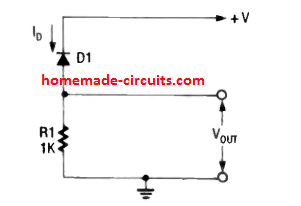
However, suppose we have the same diode with its outer opaque cover scraped of or removed and connected with a reverse bias supply. This will expose the PN junction of the diode to light, and there will be an instant flow of current through it, in response to the incident light.
This may result in a current as much as 1 mA through the diode, causing a rising voltage to develop across R1.
The photodiode in the above figure can be also connected on the ground side as shown below. This will produce a opposite response, resulting in a decreasing voltage across R1, when the photodiode is illuminated with external light.
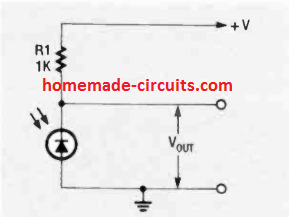
The working of all P-N junction based devices is similar and will exhibit photo-conductivity when exposed to light.
The schematic symbol of a photodiode can be see below.
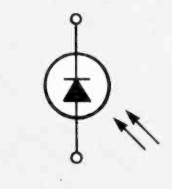
Compared to cadmium-sulphide or cadmium-selenide photocells like LDRs, photodiodes are generally less sensitive to light, but their response to light changes is much faster.
Due to this reason, photocells like LDRs are generally used in applications that involve visible light, and where the response time does not need to be quick. On the other hand, photodiodes are specifically selected in applications that require fast detection of lights mostly in the infrared region.
You will find photodiodes in systems such as infrared remote control circuits, beam interruption relays and intruder alarm circuits.
There's another variant of photodiode which uses lead-sulfide (PbS) and there working characteristic is quite similar to LDRs but are designed to respond only to the infrared range lights.
Phototransistors
The following image shows the schematic symbol of a phototransistor
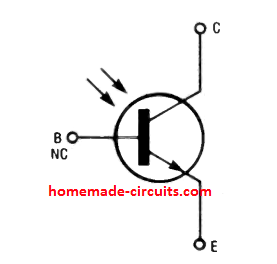
The phototransistor is generally in the form of a bipolar NPN silicon transistor encapsulated in a cover with a transparent opening.
It works by allowing light to reach the PN junction of the device through the transparent opening. The light reacts with the exposed PN junction of the device, initiating the photoconductivity action.
A phototransistor is mostly configured with its base pin unconnected as shown in the following two circuits.
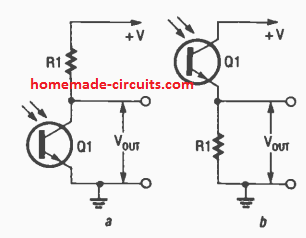
In the left side figure the connection effectively causes the phototransistor to be in the reverse bias situation, such that it now works like a photodiode.
Here, the current generated due to light across the base collector terminals of the device is directly fed back to the base of the device, resulting in the normal current amplification and the current flowing out as the output from the collector terminal of the device.
This amplified current causes a proportionate amount of voltage to develop across the resistor R1.
Phototransistors may show identical amounts of current at their collector and emitter pins, due to an open base connection, and this prevents the device from a negative feedback.
Due to this feature, if the phototransistor is connected as shown at the right side of the above figure with R1 across emitter and ground, the outcome is exactly identical as it had been for the left side configuration. Meaning for both the configurations, the voltage developed across R1 due to phototransistor conduction is similar.
Difference between Photodiode and Phototransistor
Although the working principle is similar for the two counterparts, there are a few noticeable differences between them.
A photodiode may be rated to work with much higher frequencies in the range of tens of megahertz, as opposed to a phototransistor which is restricted to only a few hundred kilohertz.
The presence of the base terminal in a phototransistor makes it more advantageous compared to a photodiode.
A phototransistor can be converted to work like a photodiode by connecting its base with ground as shown below, but a photodiode may not have the ability to work like a phototransistor.
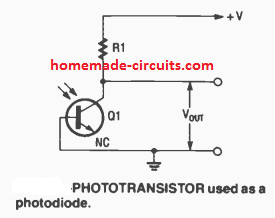
Another advantage of the base terminal is that the sensitivity of a phototransistor can be made variable by introducing a potentiometer across base emitter of the device as shown in the following figure.
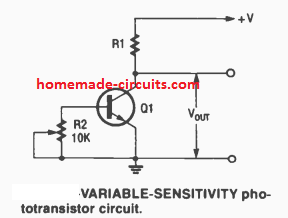
In the above arrangement the device works like a variable sensitivity phototransistor, but if the pot R2 connections are removed, the device acts like a normal phototransistor, and if R2 is shorted to ground, then the device turns into a photodiode.
Selecting the Biasing Resistor
In all the circuit diagrams shown above the selection of R1 value is usually a balance between voltage gain and bandwidth response of the device.
As the value of R1 is increased the voltage gain increases but the useful operating bandwidth range decreases, and vice versa.
Furthermore, the value of R1 should be such that the devices are forced to work in their linear region. This can be done with some trial and error.
Practically for operating voltages from 5V and 12V any value between 1K and 10K is usually sufficient as R1.
Darlington phototransistors
These are similar to a normal darlington transistor with their internal structure. Internally these are built using two transistors coupled with each other as shown in the following schematic symbol.
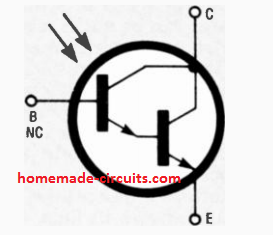
The sensitivity specifications of a photodarlington transistor may be approximately 10 times higher than that of a normal phototransistor. However, the working frequency of these units are lower than the normal types, and may be restricted to only some 10s of kilohertz.
Photodiode Phototransistor Applications
The best example of photodiode and phototransistor application may be in field of lightwave signal receivers or detectors in fiber optic transmission lines.
The lightwave passing via an optical fiber can be effectively modulated both through analog or digital techniques.
Photodiodes and phototransistors are also widely used for making detectors stages in optocouplers and infrared light beam interruption devices and intruder alarm gadgets.
The problem while designing these circuits is that, the intensity of light falling on the photo sensitive devices could be very strong or weak, and also these may encounter external disturbances in the form of random visible lights, or infrared interference.
To counter these issues, these application circuits are normally operated with optical links having a specific infrared carrier frequency. Moreover the input side of the receiver is reinforced with a preamplifier so that even the weakest of the optical linking signals is detected comfortably, enabling the system with a wide range of sensitivity.
The following two applications circuits show how a foolproof implementation can be done using photodiodes through 30 kHz carrier modulation frequency.
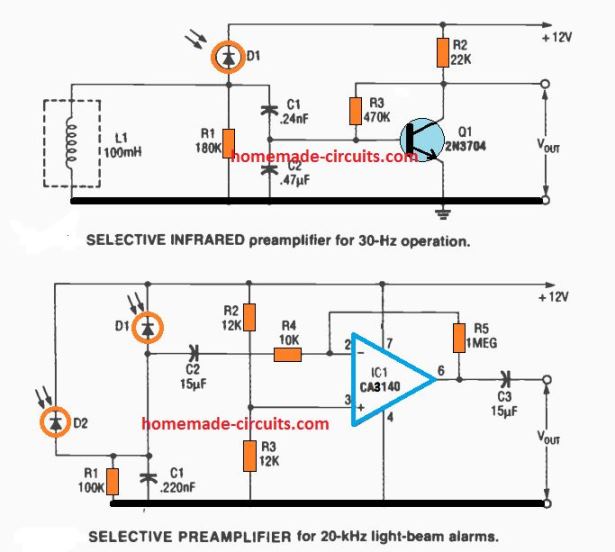
These are selective preamplifier based photodiode alarm circuits, and will respond to a specific band of frequency, ensuring a foolproof operation of the system.
In the upper design, L1, C1 and C2 filter out all other frequencies except the intended 30 Hz frequency from an infrared optical link. As soon this is detected it is further amplified by Q1, and its output becomes active for sounding an alarm system.
Alternatively, the system could be used for activating an alarm when the optical link is cut off. In this case the transistor may be kept active permanently through a 30 Hz IR focus on the phototransistor Next, the output from the transistor could be inverted using another NPN stage so that, an interruption in the 30 Hz IR beam, turns OFF Q1, and turns ON the second NPN transistor. This second transistor must integrated through a 10uF capacitor from the collector of Q2 in the upper circuit.
The lower circuit functioning is similar to the transistorized version except the frequency range which is 20 kHz for this application. It is also a selective preamplifier detection system tuned to detect IR signals having a modulation frequency of 20 kHz.
As long as an IR beam tuned at 20 kHz remains focused on the photodiode, it creates a higher potential on the inverting input pin2 of the op amp which exceeds the potential divider output at the non-inverting pin of the op amp. This causes the output RMS from the op amp to be near zero.
However, the moment the beam is interrupted, causes a sudden drop of potential at the pin2, and an increase of potential at pin3. This instantly raises the RMS voltage at the output of the op amp activating the connected alarm system.
C1 and R1 are employed to bypass any unwanted signal to ground.
Two photo diodes D1 and D2 are used so that the system activates only when the IR signals are interrupted simultaneously across D1 and D2. The idea can be used in places where only long vertical targets like humans are required to be sensed, while the shorter targets like animals can be allowed to pass freely.
To implement this D1 and D2 must be installed vertically and parallel to each other, wherein D1 may be placed a feet above the ground, and D2 some 3 feet above D1 in a straight line.